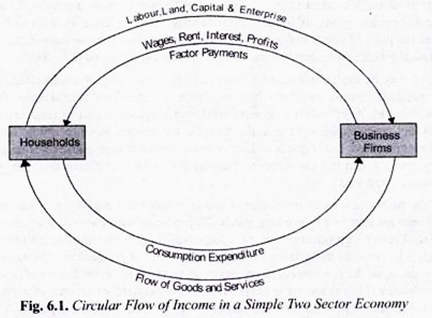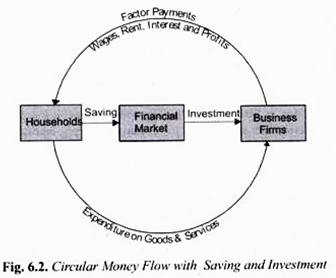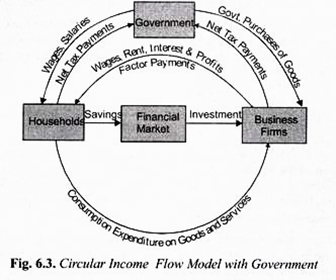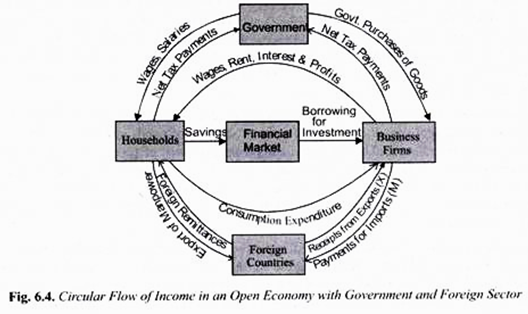Let us make in-depth study of the circular flow of income in two sector, three sector and four sector economy.
Circular Income Flow in a Two Sector Economy:
Real flows of resources, goods and services have been shown in Fig. 6.1. In the upper loop of this figure, the resources such as land, capital and entrepreneurial ability flow from households to business firms as indicated by the arrow mark.
In opposite direction to this, money flows from business firms to the households as factor payments such as wages, rent, interest and profits.

Thus we see that money flows from business firms to households as factor payments and then it flows from households to firms. Thus there is, in fact, a circular flow of money or income. This circular flow of money will continue indefinitely week by week and year by year. This is how the economy functions. It may, however, be pointed out that this flow of money income will not always remain the same in volume.
ADVERTISEMENTS:
In other words, the flow of money income will not always continue at a constant level. In year of depression, the circular flow of money income will contract, i.e., will become lesser in volume, and in years of prosperity it will expand, i.e., will become greater in volume.
This is so because the flow of money is a measure of national income and will, therefore, change with changes in the national income. In year of depression, when national income is low, the volume of the flow of money will be small and in years of prosperity when the level of national income is quite high, the flow of money will be large.
In order to make our analysis simple and to explain the central issues involved, we take many assumptions. In the first place, we assume that neither the households save from their incomes, nor the firms save from their profits. We further assume that the government does not play any part in the national economy.
ADVERTISEMENTS:
In other words, the government does not receive any money from the people by way of taxes, nor does the government spend any money on the goods and services produced by the firms or on the resources and services supplied by the households. Thirdly, we assume that the economy neither imports goods and services, nor exports anything. In other words, in our above analysis we have not taken into account the role of foreign trade. In fact we have explained above the flow of money that occurs in the functioning of a closed economy with no savings and no role of government.
Circular Income Flow with Saving and Investment:
In our above analysis of the circular flow of income we have assumed that all income which the households receive, they spend it on consumer goods and services. A result, circular flow of money speeding and income remains undiminished. We will now explain if households save a part of their income, how their savings will affect money flows in the economy.
When households save, their expenditure on goods and services will decline to that extent and as a result money flow to the business firms will contract. With reduced money receipts, firms will hire fewer workers (or lay off some workers) or reduce the factor payments they make to the suppliers of factors such as workers.
This will lead to the fall in total incomes of the households. Thus, savings reduce the flow of money expenditure to the business firms and will cause a fall in economy’s total income. Economists therefore call savings a leakage from the money expenditure flow.
ADVERTISEMENTS:
But savings by households need not lead to reduced aggregate spending and income if they find their way back into flow of expenditure. In free market economies there exists a set of institutions such as banks, insurance companies, financial houses, stock markets where households deposit their savings. All these institutions together are called financial institutions or financial market. We assume that all the savings of households come in the financial market. We further assume that there are no inter-households borrowings.
It is business firms who borrow from the financial market for investment in capital goods such as machines, factories, tools and instruments, trucks. Firms spend on investment in order to expand their productive capacity in future.
Thus, through investment expenditure by borrowing the savings of the households deposited in financial market, are again brought into the expenditure stream and as a result total flow of spending does not decrease. Circular money flow with saving and investment is illustrated in Fig. 6.2 where in the middle part a box representing financial market is drawn. Money flow of savings is shown from the households towards the financial market. Then flow of investment expenditure is shown as borrowing by business firms from the financial market.
Condition for the Constancy of Circular Income Flow:
Now the question arises what is the condition for the flow of money income to continue at a steady level so that it makes possible the production and subsequent flow of a given volume of goods and services at constant prices. To explain this we have to introduce saving and investment in the analysis of circular flow of income.
Saving a part of income means it is not spent on consumer goods and services. In other words, saving is withdrawal of some money from the income flow. On the other hand, investment means some money is spent on buying new capital goods to expand production capacity. In other words, investment is injection of some money in circular flow of income.
For the circular flow of income to continue unabated, the withdrawal of money from the income stream by way of saving must equal injection of money by way of investment expenditure. Therefore, planned savings must be equal to planned investment if the constant money income flow in an economy is to be obtained.
Now, what will happen if planned investment expenditure falls short of the planned savings? As a result of fall in planned investment expenditure, income, output and employment will fall and therefore the flow of money will contract.
If the equality between planned savings and planned investment is disturbed by increase in savings, then the immediate effect will be that the stocks of goods lying in the shelves of the shops will increase (as some of the goods will not be sold due to the fall in consumption i.e., increase in savings). Owing to the deficiency of demand for goods and the accumulation of stocks, retailers will place small orders with the wholesalers. Consequently, smaller amount of goods will be produced and therefore fewer capital goods like machinery will be indeed with the result that fixed investment will tend to fall.
ADVERTISEMENTS:
Thus the ultimate effect of either the fall in planned investment or the increase in planned savings is the same, namely, the fall in income, output, employment and prices with the result that the flow of money will contract.
On the other hand, if the equality between planned savings and planned investment is disturbed by the increase in investment demand, the result will be increase in income, output and employment. Consequently, the flow of money income will expand.
It is thus clear from the above analysis that the flow of money income will continue at a constant level only when the condition of equality between planned saving and investment is satisfied. It was believed by classical economists that financial market provides a mechanism which coordinates the savings of households and the investment expenditure, by the firms. Rate of interest, which is the price for the use of savings, is determined by saving and investment.
If savings exceed investment expenditure, rate of interest falls so that, at a lower rate of interest, investment increases and both become equal. On the contrary, if investment expenditure is greater than savings, rate of interest will rise so that at a higher rate of interest savings increase and become equal to planned investment expenditure.
ADVERTISEMENTS:
However, an eminent British economist J.M. Keynes refuted the above argument that changes in rate of interest will cause saving and investment to become equal. According to him, since in a free market capitalist economy, investment is made by business enterprises and savings are mostly done by households and for different reasons, there is no guarantee that planned investment will be equal to planned savings and thus fluctuations in income, output and employment are inevitable.
As a result, circular flow of income does not continue at a steady level in a free-enterprise capitalist economy unless certain corrective and preventive steps are taken by the government to maintain stability in the economy.
Saving-Investment Identity in National Income Accounts in a Two Sector Economy:
Despite the fact that people who save are different from the business firms which primarily invest, in national income accounts savings are identical or always equal to investment in a simple two sector economy having no roles of Government and foreign trade. This is a basic identity in national income accounts which needs to be carefully understood.
Of course, in our above analysis of circular flow of income, we explained that planned investment by business firms can differ from savings by household. But in that analysis we referred to planned or intended investment and savings which often differ and affect the flow of national income.
ADVERTISEMENTS:
However, in national income accounts we are concerned with actual saving and actual investment. It is these actual or realised saving and investment that are identical in national income accounts. We can prove their identity in the following way.
In a simple economy which has neither government, nor foreign trade, the value of output produced which we denote by Y is equal to the value of output sold. Since the value of output sold in a simple two sector economy is equal to the sum of consumption expenditure and investment expenditure we have y= C+ I where Y = Value of aggregate output, C = Consumption expenditure and I = Investment expenditure.
A pertinent question which arises here is what happens to the unsold output. The unsold output leads to the increase in the inventories of goods and in national income accounting increase in inventories of goods is treated as a part of actual investment. This may be considered as the firms selling the goods to themselves to add to their inventories. Thus, gross national product (GNP) produced is used either for consumption or for investment.
Now, look at the gross national product or income in the simple economy from the viewpoint of its allocation between consumption and saving. Since national income (which is equal to GNP) can be either consumed or saved,. We have Y Ξ C+ S
From the identities (i) and (ii) we get
C+ I Ξ Y Ξ C+ S
ADVERTISEMENTS:
The left hand side of the identity (iii), namely C + I = Y shows the components of aggregate demand (that is, aggregate expenditure on goods and services produced) and the right-hand side of the identity (iii) namely Y = C + S shows the allocation of national income to either consumption or saving. Thus, the identity (iii) shows that the value of output produced or sold is equal to the total income received. It is income received that is spent on goods and services produced.
Now subtracting the consumption (C) from both sides of the identity (iii) we have
I Ξ Y Ξ S
or I = S
Thus, in our two sector simple economy with neither government, nor foreign trade, investment is identically equal to saving.
Circular Income Flow in a Three Sector Economy with Government:
In our above analysis of money flow, we have ignored the existence of government for the sake of making our circular flow model simple. This is quite unrealistic because government absorbs a good part of the incomes earned by households. Government affects the economy in a number of ways.
ADVERTISEMENTS:
Here we will concentrate on its taxing, spending and borrowing roles. Government purchases goods and services just as households and firms do. Government expenditure takes many forms including spending on capital goods and infrastructure (highways, power, communication), on defence goods, and on education and public health and so on. These add to the money flows which are shown in Fig. 6.3 where a box representing Government has been drawn. It will be seen that government purchases of goods and services from firms and households are shown as flow of money spending on goods and services.
Government expenditure may be financed through taxes, out of assets or by borrowing. The money flow from households and business firms to the government is labelled as tax payments in Fig. 6.3 This money flow includes all the tax payments made by households less transfer payments received from the Government. Transfer payments are treated as negative tax payments.
Another method of financing Government expenditure is borrowing from the financial market. This can be represented by the money flow from the financial market to the Government and is labelled as Government borrowing (To avoid confusion we have not drawn this money flow from financial market to the Government). Government borrowing increases the demand for credit which causes rate of interest to rise.
The government borrowing through its effect on the rate of interest affects the behaviour of firms and households. Business firms consider the interest rate as cost of borrowing and the rise in the interest rate as a result of borrowing by the Government lowers private investment. However, households who view the rate of interest as return on savings feel encouraged to save more.
It follows from above that the inclusion of the Government sector significantly affects the overall economic situation. Total expenditure flow in the economy is now the sum of consumption expenditure (denoted by C), investment expenditure (I) and Government expenditure (denoted by G). Thus
ADVERTISEMENTS:
Total expenditure (E) = C + I + G …..(i)
Total income (K) received is allocated to consumption (C), savings (S) and taxes (T). Thus
Y = C + S + T … (ii)
Since expenditure) made must be equal to the income received (Y), from equations (i) and (ii) above we have
C + I + G = C + S + T … (iii)
Since C occurs on both sides of the equation (iii) and will therefore be cancelled out, we have
ADVERTISEMENTS:
I + G = S + T …(iv)
By rearranging we obtain
G – T = S – I … (v)
Equation (v) is very significant as it depicts what would be the consequences if government budget is not balanced, that is, if Government expenditure (G) is greater than the tax revenue (7), that is, G >T, the government will have a deficit budget. To finance the deficit budget, the Government will borrow from the financial market.
For this purpose, then private investment by business firms must be less than the savings of the households. Thus Government borrowing reduces private investment in the economy. In other words, Government borrowing crowds out private investment.
Money Income Flows in the Four Sector Open Economy: Adding Foreign Sector:
We now turn to explain the money flows that are generated in an open economy, that is, economy which have trade relations with foreign countries. Thus, the inclusion of the foreign sector will reveal to us the interaction of the domestic economy with foreign countries. Foreigners interact with the domestic firms and households through exports and imports of goods and services as well as through borrowing and lending operations through financial market. Goods and services produced within the domestic territory which are sold to the foreigners are called exports.
On the other hand, purchases of foreign-made goods and services by domestic households are called imports. Figure 6.4 illustrates additional money flows that occur in the open economy when exports and imports also exist in the economy. In our analysis, we assume it is only the business firms of the domestic economy that interact with foreign countries and therefore export and import goods and services.
A flow of money spending on imports have been shown to be occurring from the domestic business firms to the foreign countries (i.e., rest of the world). On the contrary, flow of money expenditure on exports of a domestic economy has been shown to be taking place from foreign countries to the business firms of the domestic economy.
If exports are equal to the imports, then there exists a balance of trade. Generally, exports and imports are not equal to each other. If value of exports exceeds the value of imports, trade surplus occurs. On the other hand if value of imports exceeds value of exports of a country, trade deficit occurs.
In the open economy there is interaction between countries not only through exports and imports of goods and services but also through borrowing and lending funds or what is also called financial market. These days financial markets around the world have become well integrated.
When there is a trade surplus in the economy, that is, when exports (X) exceed imports (M), net capital inflow will take place. By net capital inflow we mean foreigners will borrow from domestic savers to finance their purchases of domestic exports. In this way as a result of net capital inflow domestic savers will lend to foreigners, that is, acquire foreign financial assets.
On the contrary, in case of import surplus, that is, when imports are greater than exports, trade deficit will occur. Therefore, in case of trade deficit, domestic consumer households and business firms will borrow from abroad to finance their excess of imports over exports. As a result, foreigners will acquire domestic financial assets.
From the circular flows that occur in the open economy the national income must be measured by aggregate expenditure that includes net exports, that is, X-M where X represents exports and M represents imports. Imports must be subtracted from the total expenditure on foreign produced goods and services to get the value of net exports. Thus, in the open economy
National Income = C + I + G + NX
where NX represents net exports, X-M.
Since national income can be either consumed, saved or paid as taxes to the Government we have
C + I + G + NX = C + S + T


